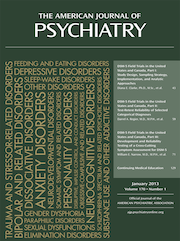DSM-5 Field Trials in the United States and Canada, Part I: Study Design, Sampling Strategy, Implementation, and Analytic Approaches
Abstract
Objective
This article discusses the design, sampling strategy, implementation, and data analytic processes of the DSM-5 Field Trials.
Method
The DSM-5 Field Trials were conducted by using a test-retest reliability design with a stratified sampling approach across six adult and four pediatric sites in the United States and one adult site in Canada. A stratified random sampling approach was used to enhance precision in the estimation of the reliability coefficients. A web-based research electronic data capture system was used for simultaneous data collection from patients and clinicians across sites and for centralized data management. Weighted descriptive analyses, intraclass kappa and intraclass correlation coefficients for stratified samples, and receiver operating curves were computed. The DSM-5 Field Trials capitalized on advances since DSM-III and DSM-IV in statistical measures of reliability (i.e., intraclass kappa for stratified samples) and other recently developed measures to determine confidence intervals around kappa estimates.
Results
Diagnostic interviews using DSM-5 criteria were conducted by 279 clinicians of varied disciplines who received training comparable to what would be available to any clinician after publication of DSM-5. Overall, 2,246 patients with various diagnoses and levels of comorbidity were enrolled, of which over 86% were seen for two diagnostic interviews. A range of reliability coefficients were observed for the categorical diagnoses and dimensional measures.
Conclusions
Multisite field trials and training comparable to what would be available to any clinician after publication of DSM-5 provided “real-world” testing of DSM-5 proposed diagnoses.



